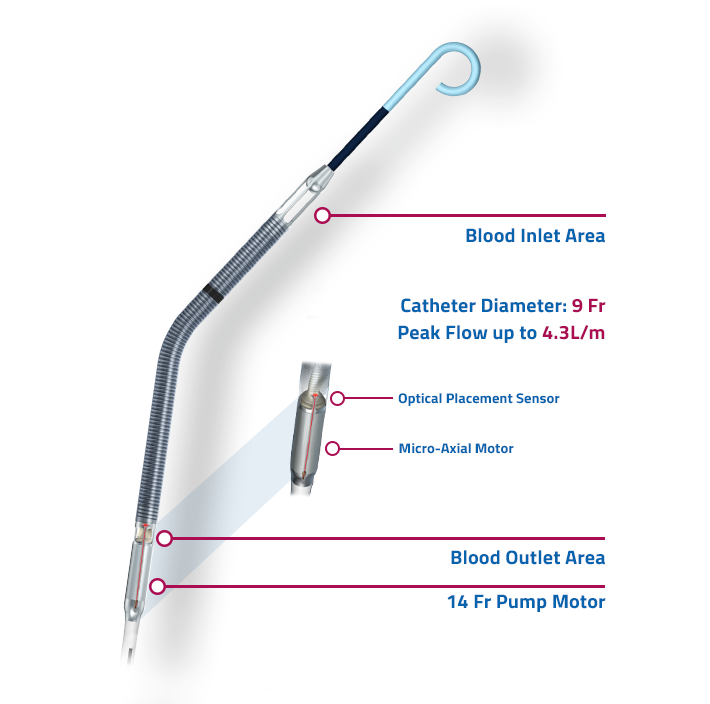
The first patient in Japan was successfully treated in October 2017 with the Impella 5.0 heart pump at Osaka University Hospital under the leadership of Professor Yoshiki Sawa, M.D., Ph.D. of the Department of Cardiovascular Surgery, Osaka University’s Graduate School of Medicine. Since then, more than 100 hospitals across Japan can now provide Impella support to patients and 138 hospitals have been approved by the government and the Circulatory Support Committee.
Of the first 1,000 Japanese cases, procedural outcomes data is available on the first 580 cases1). The data demonstrates improvements in AMI cardiogenic shock and myocarditis survival rates during the procedure, compared to traditional therapies:
AMI Cardiogenic Shock:
- With Impella only (n=109):
- 87% survival to Impella explant with 97% heart recovery2)
- With Impella + percutaneous cardiopulmonary support (PCPS) (n=89):
- 54% survival at explant and 75% heart recovery2)
- With PCPS only:
- 21% survival to discharge, according to the DPC Database3) and 31% survival to 30 days according to the JCS Shock Registry4)
Myocarditis:
- With Impella only and with Impella + percutaneous cardiopulmonary support (PCPS) (n=62):
- 83% survival to Impella explant
- With PCPS only:
- 43% survival to discharge according to the DPC Database3)and 52% survival according to the Sawamura CHANGE PUMP Study5)
The protocols used to introduce Impella in Japan were developed based on best practices learned from the experience treating patients in Europe and the United States, including the National Cardiogenic Shock Initiative, the Impella Quality (IQ) Database and the cVAD Study.
According to Professor Sawa, “Since the first case was implemented in October 2017, the number of patients treated with Impella heart pump has been increasing steadily. In Japan, many cardiologists understand the effectiveness of Impella as an unprecedented new option for heart treatment and they are actively working to introduce Impella in their hospitals. As a result, two years after the first case, the number of sites which can provide Impella treatment to the patient has reached more than 100 nationwide with better clinical outcomes6). I expect that the goal of Impella therapy can not only contribute to saving lives, but to heart recovery for more patients.”
“In the past two years we have accumulated clinical results safely with rigorous training and education on best practice protocols, which allowed us to achieve optimal results,” said Eizo Nishimura, president of Abiomed Japan K.K. “Impella is a new option to increase survival and heart recovery rate and turn circulatory support into ‘therapy.’ I would like to thank all the healthcare professionals for their efforts to deliver this innovative technology to more than 1,000 patients. We will continue our effort to make contributions to develop the field of heart recovery, enabling many patients to recover their heart function and return to their normal lives.”
1) Interim tracking data provided by Abiomed Japan as of March 2019
2) Percentage of survival values at Impella removal without the transfer to the circulatory assist device such as IAPB, PCPS and VAD
3) Aso, Critical Care. 2016. 20:80
4) Ueki, PE-767. JCS2016 Poster Session
5) Sawamura, Circ J 2018; 82:699-707
6) O’Neill, AHJ 2018; 202:33-38
ABOUT IMPELLA 2.5 and 5.0 HEART PUMP IN JAPAN
The Impella 2.5® and Impella 5.0® heart pumps received Pharmaceuticals and Medical Devices Agency (PMDA) approval from the Japanese Ministry of Health, Labor & Welfare (MHLW) in September 2016 and received reimbursement, effective September 2017.
In Japan, the Impella heart pump is used for the following indication: In the treatment of drug-resistant acute heart failure attributable to causes such as cardiogenic shock, a catheter is inserted percutaneously/transvascularly without chest-opening surgery, and blood is aspirated via the tip of a catheter inserted/placed into the left ventricle and pumped out via the outlet port located in the ascending aorta, thereby assisting with antegrade blood circulation in the body. It aims to improve hemodynamics and the recovery of the heart muscles through prompt assistance of antegrade blood flow in a minimally invasive manner while reducing burden on the heart muscles, allowing for prompt recovery of cardiac function.
